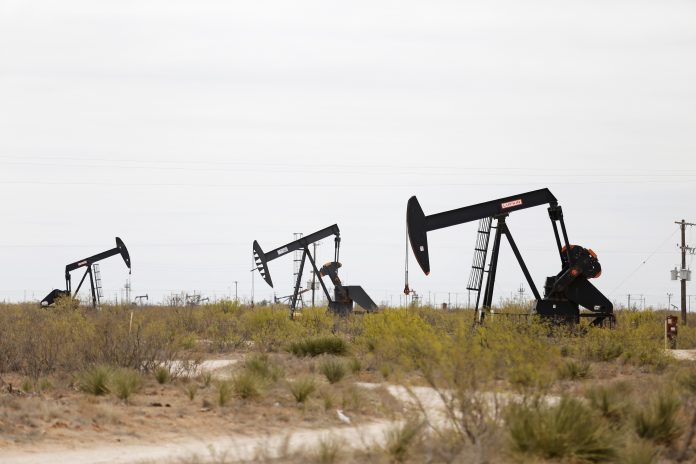
The ExxonMobil and Chevron corporations are investing billions in research and development to stay abreast of the times and look ahead to decades of stepped up activity.
Spokesmen for the world’s fourth- and seventh-biggest oil companies say a major feature of their R&D work is addressing climate change.
The Irving-based ExxonMobil reported $386.8 billion in revenues and the San Ramon, Calif.-based Chevron $227.1 billion last year, according to Investopedia.
An ExxonMobil spokesman told the Odessa American that his company’s oil and natural gas supplies were expanded to meet the growing global demand by bumping production in the Permian Basin and Guyana and starting the expansion of its 250,000-barrel-a-day Beaumont refinery.
“Compared to the first quarter of 2022, we have added 300,000 barrels per day to global supply primarily from a 40-percent increase in production from Guyana and the Permian Basin,” he said. “In upstream we increased production from our advantaged assets with high returns, low cost of supply and lower emissions intensity with good performance, controlling operating and above-field costs.
“As our results demonstrate, we’ve built a strong portfolio of advantaged businesses that are better leveraging the synergies of our integrated businesses, our scale and increasingly our unique technical capabilities.”
The ExxonMobil official reported “a sizeable increase in investments aimed at emission reductions and accretive lower-emission initiatives including our low carbon solutions business.
“The corporate plan through 2027 maintains annual capital expenditures at $20-$25 billion while growing lower-emissions investments to $17 billion for an increase of nearly 15 percent.”
He said 40 percent of these investments is directed toward building the company’s lower emissions business for customers to reduce their greenhouse gas emissions with a primary emphasis on large-scale carbon capture and storage, biofuels and hydrogen.
“These lower emissions technologies are recognized as necessary solutions to help address climate change and they closely align with ExxonMobil’s existing competitive advantages and core capabilities,” the spokesman said.
“The balance of the capital will be deployed in support of the company’s 2030 emission reduction plans and its 2050 Scope 1 and 2 net-zero ambition,” he said. “In the Permian the company is on track with its goal to reach net-zero Scope 1 and 2 emissions from its operated unconventional assets by 2030.”
Unconventional operations are those facilitated by hydraulic fracturing and directional drilling.
The ExxonMobil spokesman said efforts include in-house research and development as well as collaborative efforts with leading universities and commercial partners that are involved in advanced lower-emission energy technologies.
“Our future results and ability to grow our LCS business, help nations meet their emissions reduction goals and succeed through the energy transition will depend in part on the success of these research and collaboration efforts and on our ability to adapt and apply the strengths of our current business model to provide the energy products of the future in a cost-competitive manner,” he said.
The spokesman said adapting to a changing market is crucial.
“To maintain our competitive position, especially in light of the technological nature of our businesses and the need for continuous efficiency improvement, ExxonMobil’s technology, research and development organizations must adapt to a changing market and policy environment including the development of technologies to help reduce greenhouse gas emissions,” he said.
“To remain competitive we must also continuously adapt and capture the benefits of new and emerging technologies including successfully applying advances in the ability to process very large amounts of data to our businesses.”
The Chevron spokesman said carbon capture, utilization and storage, or CCUS, “is a critical enabler of global net zero and our commitment to accelerate progress toward the lower carbon ambitions of our customers and company.
“Chevron has decades of operational experience and a proven track record of carbon-capture projects and it is already deploying CCUS technologies in locations across the globe,” he said.
“We’re taking action by deploying CCUS to lower the carbon intensity of our existing assets and growing our CCUS business to help reduce emissions of the essential industries that enable modern society.
“We are leveraging our expertise and global reach to advance CCUS technologies and scaling viable lower carbon solutions across the value chain of capture, transport, utilization and storage with a focus on hard-to-abate, energy-intensive industries such as refining, petrochemicals, power, steel and cement.”
The Chevron spokesman said his company’s Gorgon Project on Barrow Island 120 miles west of Australia is one of the world’s largest integrated CCUS projects.
“Since Gorgon started up in mid-2019, almost seven million tons of CO2 emissions have been injected,” he said. “We are investing in emerging CCUS technologies to bring early insights through pilot programs, often using Chevron’s existing assets, and accelerate the commercialization of promising technologies.
“To achieve our ambitions we are also exploring hub opportunities in the United States and abroad.”
The rest of the world’s top 10 oil companies and their 2022 revenues are Saudi Aramco, $590.3 billion, No. 1; China Petroleum & Chemical Corp., $486.8 billion, 2; PetroChina Co., $486.4 billion, 3; Shell PLC, $365.3 billion, 5; TotalEnergies of France, $254.7 billion, 6; British Petroleum, $222.7 billion, 8; Marathon Petroleum, $173 billion, 9; and Valero Energy Corp., $170.5 billion, 10.



